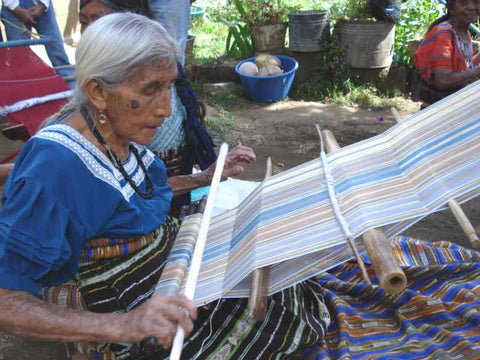Weaving on simple looms made of rods / sticks is an art that has been practiced for centuries around the world. The looms are constructed with variations, but all producing stunning textiles. I have seen in Ecuador a type of backstrap loom that was set up inside a pit on the floor. Other countries use a larger wooden structure that holds the back rod with the weaver sitting inside or on top and wearing the backstrap to produce the tension.
Education And More works with many Mayan weavers in Guatemala and many times the loom set-up and techniques used will vary from village to village. Often, even the terms for the various tools and looms parts may vary from village to village because of the different Mayan languages spoken in Guatemala. The looms are simple - usually just 6-7 rods and a belt plus rope to tie to a tree or post.
Mayan backstrap weavers are typically women, having learned from their mothers at the age of 7 or 8 years, so by the time they are in their early 20’s they are extremely skilled weavers. Weaving is still an everyday practice in the rural areas of Guatemala but the art has nearly disappeared in the cities.

Some villages are known for their brocaded textiles and many villages use extensive ikat designs in their weavings. Brocading produces intricate patterns on top of the weaving but is extremely time consuming. Many Mayan women wear heavily brocaded huipils (blouses) as part of their typical Mayan dress.

Ikat designed threads are a way for the weaver to add interest and design into their backstrap weavings. Ikat is a form of resist dyeing to make groups of threads that form designs after it is woven into the textile.

Our partner weavers keep things simple when it comes to their looms. No need to run to the market for a new shuttle, they will just use a large twig or stick found in the yard as a shuttle. They wind their yarn onto the stick in sort of a butterfly pattern and use that for a shuttle. When they throw the stick shuttle through the weaving they will sometimes laugh and say ‘feed the loom’ or ‘give it food.’ I can imagine them saying this when teaching their daughters not only to have fun but also to give them a way to remember one of the weaving steps.
In the rural areas of the western highlands most of the women weave with cotton yarn, however in some villages they will use acrylic yarn and at times even use both cotton and acrylic in one weaving. Both the acrylic and cotton yarn that is used are extremely fine -- similar to 18/2 size yarn here in the United States. Using these fine yarns makes an extremely durable and long lasting textile.

Below is a typical backstrap loom setup for Mayan women in the highlands of Guatemala.

The parts of the loom are called:
- urdidor -- warping table / board
- espalda - batten
- hilo - yarn
- lanzadera - shuttle
- trama - weft
- fondo - warp
- palitos - bars / rods
- cinteron - backstrap belt
- juego de palitos - backstrap loom
- devanador - wooden yarn winder

Two sites online where you can learn more about backstrap weaving or where you can purchase authentic looms.
Laverne Waddington’s Backstrap WeavingThe Fair Line by Education And More Weaving Looms and Accessories

1 comment
Am just asking for permission to use your articles in teaching process